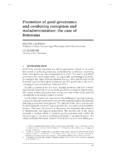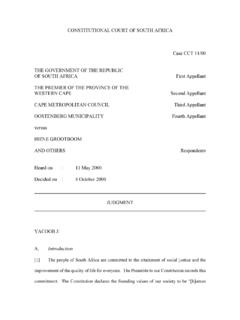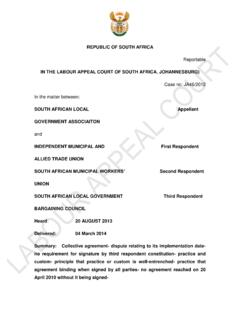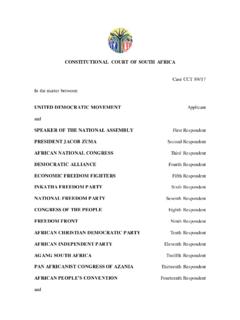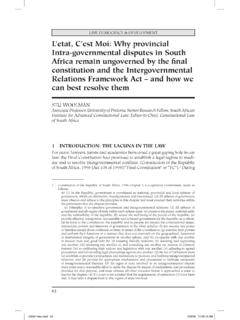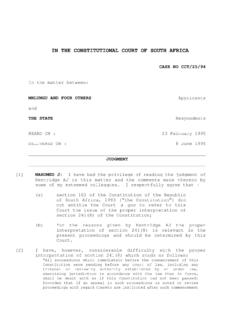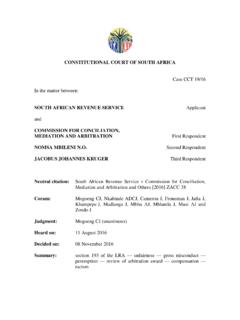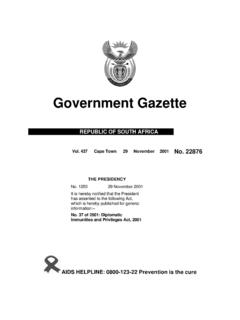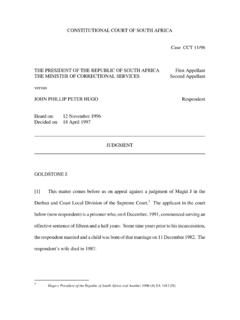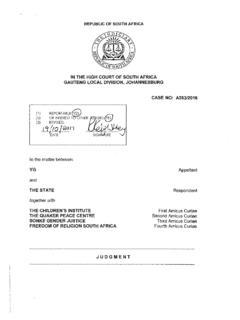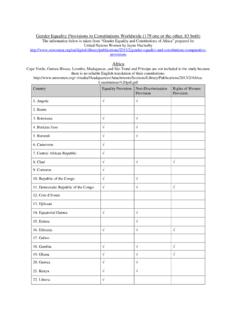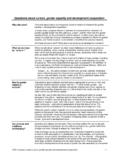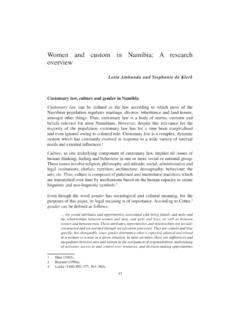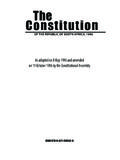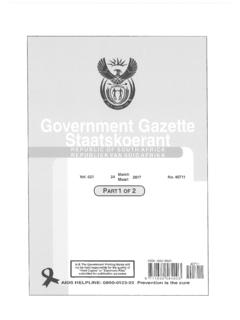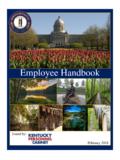Transcription of GENERAL INDEX - SAFLII Home
1 GENERAL INDEXCHAPTER AND POLITICAL CONTEXT AND OF THE NEW TEXT BY THE ADOPTED BY THE NATURE OF THE COURT S CERTIFICATION OF THE CERTIFICATION OF THE CONSTITUTIONAL OF 8(2): HORIZONTAL 8(4): JURISTIC 12(2): RIGHT TO BODILY 23: LABOUR Right of Individual Employers to Bargain 25: 26 to 29: SOCIO-ECONOMIC 29: EDUCATION IN THE LANGUAGE OF 32 READ WITH NT SCH 6 S 23(2)(a): ACCESS 35(1)(f): 36(1): LIMITATIONS OF 37: STATES OF AND FAMILY GOVERNMENT OF POWERS BETWEEN THE LEGISLATURE ANDTHE POWER OF THE PRESIDENT TO ISSUE AND THE ADMINISTRATION OF Service of the Prosecuting of Lay Persons in Court LEGISLATION FROM CONSTITUTIONAL SCRUTINY..86NT 241(1)..86NT sch 6 s 22(1).. THE of Constitutional Provisions: NT 74.
2 88 Entrenchment of the Bill of Service Rights Commission, Commission for the Promotion and Protectionof the Rights of Cultural, Religious and Linguistic Communitiesand Commission for Gender of Traditional Traditional Leadership by Horizontal Application of the Billof of the XIV: Participation in the Political Process by Minority Parties127 CHAPTER GOVERNMENT ISSUES (OTHER THAN ).. OF THE CONSTITUTIONAL PROVINCIAL XIX ..142CP 44(2)..146NT 125(3)..148NT 147(1)..150NT ch ch Oversight ..164 Other GOVERNMENT POWERS (CP ).. INTERPRETATION AND APPLICATION OF CP NATIONAL COUNCIL OF POWERS: NT SCHS 4 AND 5 COMPARED WITH ICSCH WITH RESPECT TO LOCAL : Diminution of Government Transition Act 209 of Provisions of the Interim Constitution and the New Text197 The Comparison under CP Source and Ambit of Provincial Legislative Powers and Provincial Legislative Competence in Respect of LocalGovernment Powers of the or Regulatory Powers of the National Legislature and SERVICE Provisions of the Interim Provisions of the New for Purposes of CP WITH REGARD TO TRADITIONAL Legislative of 214: The Provinces Equitable Shares of Controls.
3 238 Treasury Controls and and Fiscal WEIGHING OF THE Institutional Instrument Through Which Provincial Powers andFunctions are Expressed at the National African Police Power to Make Provincial and Fiscal Powers and Public Service Powers of Powers of Provincial Competence (Excluding Those SpecificallyDiscussed)..251 Provincial Executive Power of the National Government to Intervene in or to Override theExercise of Provincial Power of a Province to Resist National Legislation which SpecificallyAffects a Particular Province or Regarding CP VIII. CONCLUSION AND 1: 2: CONSTITUTIONAL 3: SUMMARY OF OBJECTIONS AND 4: ABBREVIATIONS IN THE is the unanimous judgment of the available members of the Court. Ackermann J, who had initiallyparticipated in the Court s consideration of this matter, fell ill during the hearing of oral heard legal argument and other representations on behalf of those parties who had the right ofaudience, the remaining members of the Court concluded that the proceedings would have to continuewithout the benefit of Justice Ackermann s contribution.
4 Regrettable though it was, the provisions of s100(3)(c) of the Constitution of the Republic of South Africa, 1993 (inserted by s 2 of Act 44 of 1995)rendered such decision unavoidable in the COURT OF SOUTH AFRICACase CCT 23/96 CERTIFICATION OF THE CONSTITUTIONOF THE REPUBLIC OF SOUTH AFRICA, 1996 Heard on:1-5 and 8-11 July 1996 Decided on:6 September 1996 JUDGMENTTHE COURT:1 CHAPTER [1]The formal purpose of this judgment is to pronounce whether or not the Courtcertifies that all the provisions of South Africa s proposed new constitution comply withcertain principles contained in the country s current constitution. But its underlyingpurpose and scope are much wider. Judicial certification of a constitution isunprecedented and the very nature of the undertaking has to be explained. To do that,one must place the undertaking in its proper historical, political and legal context; and,in doing so, the essence of the country s constitutional transition, the respective roles of2the political entities involved and the applicable legal principles and terminology mustbe identified and described.
5 It is also necessary to explain the scope of the Court scertification task and the effect of this judgment, not only the extent and significance ofthe Court s powers, but also their limitations. Only then can one really come to gripswith the certification itself. [2]That is in itself a complex and wide-ranging exercise, dealing with a large numberand variety of issues, some interrelated but many not. Virtually all of those issues wereraised in written submissions and oral representations received from political parties,special interest groups and members of the public at large. But, as will be shownshortly, the certification task extends beyond considering complaints specifically drawnto the Court s attention. We certainly derived great benefit from such contributions andwish to express our appreciation to counsel for the Constitutional Assembly and thepolitical parties, to the representatives of other bodies and to the persons who submittedwritten submissions or oral argument.
6 The thoroughness of their research and thecogency of their arguments greatly eased our task. Ultimately, however, it was our dutyto measure each and every provision of the new constitution, viewed both singly and inconjunction with one another, against the stated Constitutional Principles, irrespectiveof the attitude of any interested party. In what follows we intend not only to record ourconclusions regarding that exercise, but to make plain our reasons for each suchconclusion. 2 Annexure 1 is a list of appearances; Annexure 2 contains the text of the Constitutional Principles;Annexure 3 identifies each of the objectors (other than political parties) and the nature of theirobjections; and Annexure 4 is a list of [3]We may however be called upon in future and in the context of a concrete disputeto deal with constitutional provisions we have had to construe in the abstract for thepurposes of the certification process.
7 In order to avoid pre-empting decisions in suchcases, we have endeavoured, where possible, to be brief and to provide reasons for ourdecisions without saying more than is necessary.[4]In order to contain this judgment within manageable proportions, use has beenmade of The multiplicity of issues involved has also necessitated dividingthe judgment into separate Chapters, each dealing in the main with a specific dealt with in different Chapters are sometimes interrelated, however, anddifferent aspects thereof may be touched on in more than one Chapter. As this maymake it difficult to follow the thread of the discussion of a particular subject, we havealso included an INDEX . Extensive use has been made of abbreviations. These havebeen identified in the text, but a schedule of abbreviations has been provided to facilitatereading of only parts of the AND POLITICAL CONTEXT[5]South Africa s past has been aptly described as that of a deeply divided societycharacterised by strife, conflict, untold suffering and injustice which generated grossviolations of human rights, the transgression of humanitarian principles in violent3 See the first and third paragraphs of the postscript, headed National Unity and Reconciliation , to theConstitution of the Republic of South Africa Act 200 of 1993.
8 That Act will hereafter be referred to asthe Interim Constitution or the IC and the sections thereof as, for example, IC 25".4In the Cape Province persons of certain other ethnic origins enjoyed a limited franchise and there wasprovision for representation in the national legislature of African interests by and a legacy of hatred, fear, guilt and revenge .3 From the outset the countrymaintained a colonial heritage of racial discrimination: in most of the country thefranchise was reserved for white males4 and a rigid system of economic and socialsegregation was enforced. The administration of African tribal territories through vassal traditional authorities passed smoothly from British colonial rule to the newgovernment, which continued its predecessor s policy.
9 [6]At the same time the Montesquieuan principle of a threefold separation of statepower - often but an aspirational ideal - did not flourish in a South Africa which, underthe banner of adherence to the Westminster system of government, actively promotedparliamentary supremacy and domination by the executive. Multi-party democracy hadalways been the preserve of the white minority but even there it had languished since1948. The rallying call of apartheid proved irresistible for a white electorate embattledby the spectre of decolonisation in Africa to the north. [7]From time to time various forms of limited participation in government weredevised by the minority for the majority, most notably the homeland policy which wascentral to the apartheid system. Fundamental to that system was a denial of socio-5 For people who were not classified as either European or Bantu , apartheid theory did not purport tooffer a rationale for its student unrest, which started in Soweto on 16 June, escalated and spread to many parts of and economic rights to the majority in the bulk of the country, which wasidentified as white South Africa , coupled with a Balkanisation of tribal territories inwhich Africans would theoretically become entitled to enjoy all Race was thebasic, all-pervading and inescapable criterion for participation by a person in all aspectsof political, economic and social life.
10 [8]As the apartheid system gathered momentum during the 1950s and came to beenforced with increasing rigour, resistance from the disenfranchised - and increasinglydisadvantaged - majority intensified. Many (and eventually most) of them demandednon-discriminatory and wholly representative government in a non-racial unitary state,tenets diametrically opposed to those of apartheid. Although there were reappraisalsand adaptations on both sides as time passed, the ideological chasm remained apparentlyunbridgeable until relatively recently.[9]The clash of ideologies not only resulted in strife and conflict but, as theconfrontation intensified, the South African government of the day - and some of the self-governing and independent territories spawned by apartheid - became more and morerepressive.
